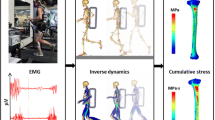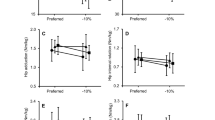Abstract
Purpose
The aim of the current investigation was to utilize a musculoskeletal simulation-based approach, to examine the effects of barefoot and shod running on lower extremity joint loading during the stance phase.
Methods
Twelve male runners, ran over an embedded force plate at 4.0 m/s, in both barefoot and shod conditions. Kinematics of the lower extremities were collected using an eight-camera motion capture system. Lower extremity joint loading was also explored using a musculoskeletal simulation and mathematical modelling approach, and differences between footwear conditions were examined using paired samples t tests.
Results
Peak Achilles tendon force was significantly larger (P = 0.039) when running barefoot (6.85 BW) compared to shod (6.07 BW). In addition, both medial (P = 0.013) and lateral (P = 0.007) tibiofemoral instantaneous load rates were significantly larger in the barefoot (medial 289.17 BW/s and lateral 179.59 BW/s) in relation to the shod (medial 167.57 BW/s and lateral 116.40 BW/s) condition. Finally, the barefoot condition (9.70 BW) was associated with a significantly larger (P = 0.037) peak hip force compared to running shod (8.51 BW).
Conclusions
The current investigation indicates that running barefoot may place runners at increased risk from the biomechanical factors linked to the etiology of chronic lower extremity pathologies. However, future analyses using habitual barefoot runners, are required before more definitive affirmations regarding injury predisposition can be made.



Similar content being viewed by others
References
http://www.sportengland.org/media-centre/news/2014/september/05/sport-england-joins-the-great-north-run-team/. Accessed 5 Oct 2017
Warburton DE, Nicol CW, Bredin SS (2006) Health benefits of physical activity: the evidence. CMAJ 174:801–809. https://doi.org/10.1503/cmaj.051351
van Gent RN, Siem D, van Middelkoop M, van Os AG, Bierma-Zeinstra SMA, Koes BW (2007) Incidence and determinants of lower extremity running injuries in long distance runners: a systematic review. Br J Sports Med 41:469–480. https://doi.org/10.1136/bjsm.2006.033548
Crossley KM (2014) Is patellofemoral osteoarthritis a common sequela of patellofemoral pain? Br J Sports Med 48:409–410. https://doi.org/10.1136/bjsports-2014-093445
Crossley KM, Stefanik JJ, Selfe J, Collins NJ, Davis IS, Powers CM, McConnell J, Vicenzino B, Bazett-Jones BM, Esculier J-F, Morrissey D, Callaghan MJ (2016) Patellofemoral pain consensus statement from the 4th international patellofemoral pain research retreat, Manchester. Part 1: Terminology, definitions, clinical examination, natural history, patellofemoral osteoarthritis and patient-reported outcome measures. Br J Sports Med 50:839–843. https://doi.org/10.1136/bjsports-2016-096384
Collins NJ, Bierma-Zeinstra SM, Crossley KM, van Linschoten RL, Vicenzino B, van Middelkoop M (2012) Prognostic factors for patellofemoral pain: a multicentre observational analysis. Br J Sports Med 47:227–233. https://doi.org/10.1136/bjsports-2012-091696
Thomas MJ, Wood L, Selfe J, Peat G (2010) Anterior knee pain in younger adults as a precursor to subsequent patellofemoral osteoarthritis: a systematic review. BMC Musculoskelet Disord 11:201–211. https://doi.org/10.1186/1471-2474-11-201
Taunton JE, Ryan MB, Clement DB, McKenzie DC, Lloyd-Smith DR, Zumbo BD (2002) A retrospective case–control analysis of 2002 running injuries. Br J Sports Med 36:95–101. https://doi.org/10.1136/bjsm.36.2.95
Wise BL, Niu J, Yang M, Lane NE, Harvey W, Felson DT, Lewis CE (2012) Patterns of compartment involvement in tibiofemoral osteoarthritis in men and women and in whites and African Americans. Arthritis Care Res 64:847–852. https://doi.org/10.1002/acr.21606
Morgenroth DC, Medverd JR, Seyedali M, Czerniecki JM (2014) The relationship between knee joint loading rate during walking and degenerative changes on magnetic resonance imaging. Clin Biomech 29:664–670. https://doi.org/10.1016/j.clinbiomech.2014.04.008
Schipplein OD, Andriacchi TP (1991) Interaction between active and passive knee stabilizers during level walking. J Orthop Res 9:113–119
Van Ginckel A, Thijs Y, Hesar NGZ, Mahieu N, De Clercq D, Roosen P, Witvrouw E (2008) Intrinsic gait-related risk factors for Achilles tendinopathy in novice runners: a prospective study. Gait Posture 29:387–391. https://doi.org/10.1016/j.gaitpost.2008.10.058
Cook JL, Purdam CR (2009) Is tendon pathology a continuum? A pathology model to explain the clinical presentation of load-induced tendinopathy. Br J Sports Med 43:409–416. https://doi.org/10.1136/bjsm.2008.051193
Shorten MA (2000) Running shoe design: protection and performance. In: Tunstall Pedoe D (ed) Marathon medicine. Royal Society of Medicine, London, pp 159–169
Lieberman DE, Venkadesan M, Werbel WA, Daoud AI, D’Andrea S, Davis IS, Mang’eni RO, Pitsiladis Y (2010) Foot strike patterns and collision forces in habitually barefoot versus shod runners. Nature 463:531–535. https://doi.org/10.1038/nature08723
Sinclair J, Greenhalgh A, Edmundson CJ, Brooks D, Hobbs SJ (2013) The influence of barefoot and barefoot-inspired footwear on the kinetics and kinematics of running in comparison to conventional running shoes. Footwear Sci 5:45–53. https://doi.org/10.1080/19424280.2012.693543
Sinclair J, Hobbs SJ, Currigan G, Taylor PJ (2013) A comparison of several barefoot inspired footwear models in relation to barefoot and conventional running footwear. Comp Exerc Phys 9:13–21. https://doi.org/10.3920/CEP13004
Bonacci J, Vicenzino B, Spratford W, Collins P (2013) Take your shoes off to reduce patellofemoral joint stress during running. Br J Sports Med 48:425–428. https://doi.org/10.1136/bjsports-2013-092160
Sinclair J (2014) Effects of barefoot and barefoot inspired footwear on knee and ankle loading during running. Clin Biomech 29:395–399. https://doi.org/10.1016/j.clinbiomech.2014.02.004
Herzog W, Longino D, Clark A (2003) The role of muscles in joint adaptation and degeneration. Langenbecks Arch Surg 388:305–315. https://doi.org/10.1007/s00423-003-0402-6
Herzog W, Clark A, Wu J (2003) Resultant and local loading in models of joint disease. Arthritis Care Res 49:239–247. https://doi.org/10.1002/art.11004
Delp SL, Anderson FC, Arnold AS, Loan P, Habib A, John CT, Thelen DG (2007) OpenSim: open-source software to create and analyze dynamic simulations of movement. IEEE Trans Biomed Eng 54:1940–1950. https://doi.org/10.1109/TBME.2007.901024
Sinclair J, Edmundson CJ, Brooks D, Hobbs SJ (2011) Evaluation of kinematic methods of identifying gait events during running. Int J Sports Sci Eng 5:188–192
Shultz R, Birmingham T, Jenkyn TR (2008) Validation of windows for examining kinematics of the foot with respect to the shoe using a multi-segment foot model. J Foot Ankle Res 1:29–34. https://doi.org/10.1186/1757-1146-1-S1-O29
Sinclair J, Greenhalgh A, Taylor PJ, Edmundson CJ, Brooks D, Hobbs SJ (2013) Differences in tibiocalcaneal kinematics measured with skin-and shoe-mounted markers. Hum Mov 14:64–69. https://doi.org/10.2478/humo-2013-0005
Sinclair J, Taylor PJ, Atkins S (2015) Influence of running shoes and cross-trainers on Achilles tendon forces during running compared with military boots. J R Army Med Corps 161:140–143. https://doi.org/10.1136/jramc-2014-000308 (Epub 2014 Nov 26)
Lerner ZF, DeMers MS, Delp SL, Browning RC (2015) How tibiofemoral alignment and contact locations affect predictions of medial and lateral tibiofemoral contact forces. J Biomech 48:644–650. https://doi.org/10.1016/j.jbiomech.2014
Steele KM, DeMers MS, Schwartz MH, Delp SL (2012) Compressive tibiofemoral force during crouch gait. Gait Posture 35:556–560. https://doi.org/10.1016/j.gaitpost.2011
Kettelkamp DB, Jacobs AW (1972) Tibiofemoral contact area-determination and implications. JBJS 54:349–356
van Eijden TM, Kouwenhoven E, Verburg J, Weijs WA (1986) A mathematical model of the patellofemoral joint. J Biomech 19:219–229. https://doi.org/10.1016/0021-9290(86)90154-5
Willson JD, Ratcliff OM, Meardon SA, Willy RW (2015) Influence of step length and landing pattern on patellofemoral joint kinetics during running. Scand J Med Sci Sports 25:736–743. https://doi.org/10.1111/sms.12383
Spoor CW, van Leeuwen JL (1992) Knee muscle moment arms from MRI and from tendon travel. J Biomech 25:201–206. https://doi.org/10.1016/0021-9290(92)90276-7
Besier TF, Draper CE, Gold GE, Beaupre GS, Delp SL (2005) Patellofemoral joint contact area increases with knee flexion and weight-bearing. J Orthop Res 23:345–350. https://doi.org/10.1016/j.orthres.2004.08.003
Almonroeder T, Willson JD, Kernozek TW (2013) The effect of foot strike pattern on Achilles tendon load during running. Ann Biomed Eng 41:1758–1766. https://doi.org/10.1007/s10439-013-0819-1
Thompson M, Gutmann A, Seegmiller J, McGowan C (2014) The effect of stride length on the dynamics of barefoot and shod running. J Biomech 47:2745–2750. https://doi.org/10.1016/j.jbiomech.2014.04.043
Sinclair J (2016) The effects of barefoot and barefoot inspired footwear running on tibiofemoral kinetics. Hum Mov 17:176–180. https://doi.org/10.1515/humo-2016-0022
Dabiri Y, Li LP (2013) Altered knee joint mechanics in simple compression associated with early cartilage degeneration. Comput Math Methods Med 11:1–12. https://doi.org/10.1155/2013/862903
Selvanetti A, Cipolla M, Puddu G (1997) Overuse tendon injuries: basic science and classification. Oper Tech Sports Med 5:110–117. https://doi.org/10.1016/S1060-1872(97)80031-7
Magnusson SP, Langberg H, Kjaer M (2010) The pathogenesis of tendinopathy: balancing the response to loading. Nat Rev Rheumatol 6:262–268. https://doi.org/10.1038/nrrheum.2010.43
Rooney BD, Derrick TR (2013) Joint contact loading in forefoot and rearfoot strike patterns during running. J Biomech 46:2201–2206. https://doi.org/10.1016/j.jbiomech.2013.06.022
Altman AR, Davis IS (2016) Prospective comparison of running injuries between shod and barefoot runners. Br J Sports Med 50:476–480. https://doi.org/10.1136/bjsports-2014-094482
Johnson VL, Hunter DJ (2014) The epidemiology of osteoarthritis. Best Pract Res Clin Rheumatol 28:5–15. https://doi.org/10.1016/j.berh.2014.01.004
Squadrone R, Gallozzi C (2009) Biomechanical and physiological comparison of barefoot and two shod conditions in experienced barefoot runners. J Sports Med Phys Fit 49:6–13
Acknowledgements
We thank Gareth Shadwell for his technical assistance.
Author information
Authors and Affiliations
Corresponding author
Ethics declarations
Conflict of interest
We declare that we have no conflict of interest.
Ethical approval
The current research project was approved by an institutional ethical panel. All procedures performed in studies involving human participants were in accordance with the ethical standards of the institutional and the Declaration of Helsinki.
Informed consent
All of the subjects provided written consent.
Rights and permissions
About this article
Cite this article
Sinclair, J. Effects of barefoot and shod running on lower extremity joint loading, a musculoskeletal simulation study. Sport Sci Health 14, 485–494 (2018). https://doi.org/10.1007/s11332-018-0446-1
Received:
Accepted:
Published:
Issue Date:
DOI: https://doi.org/10.1007/s11332-018-0446-1




